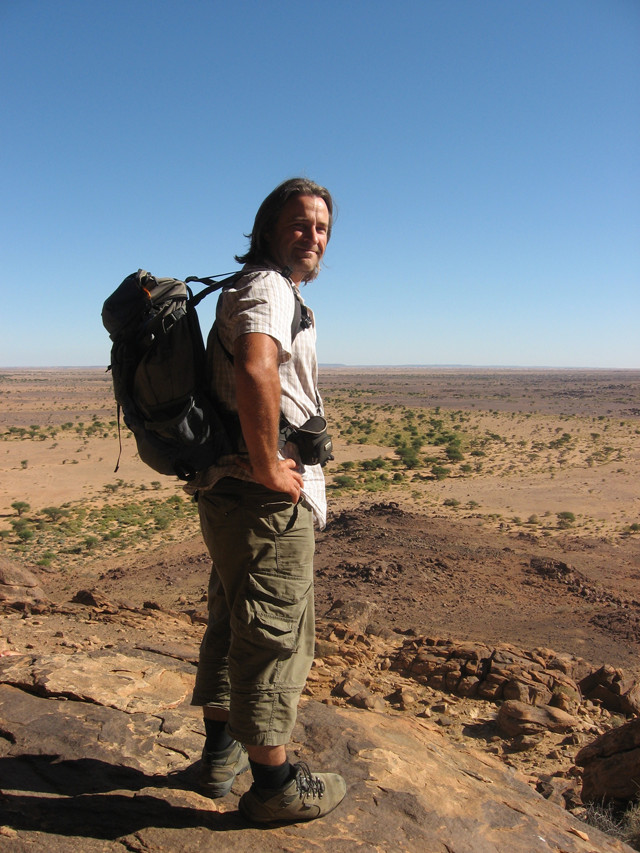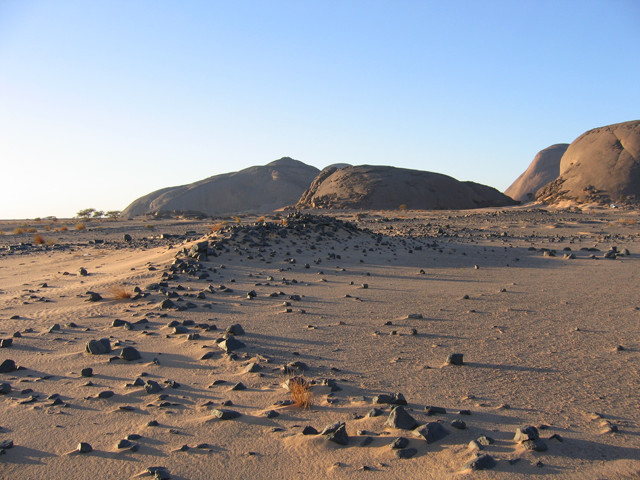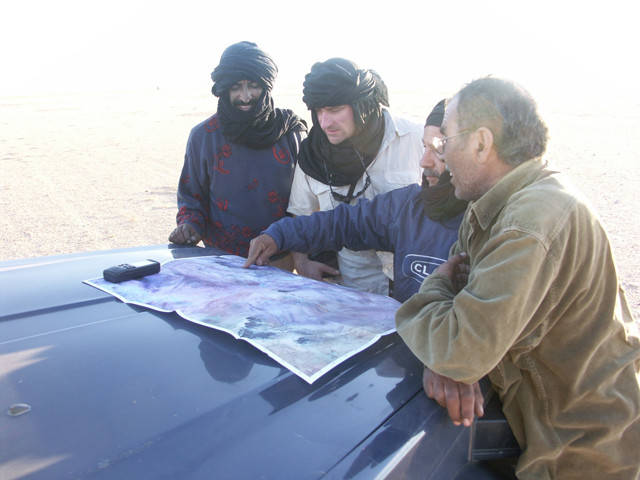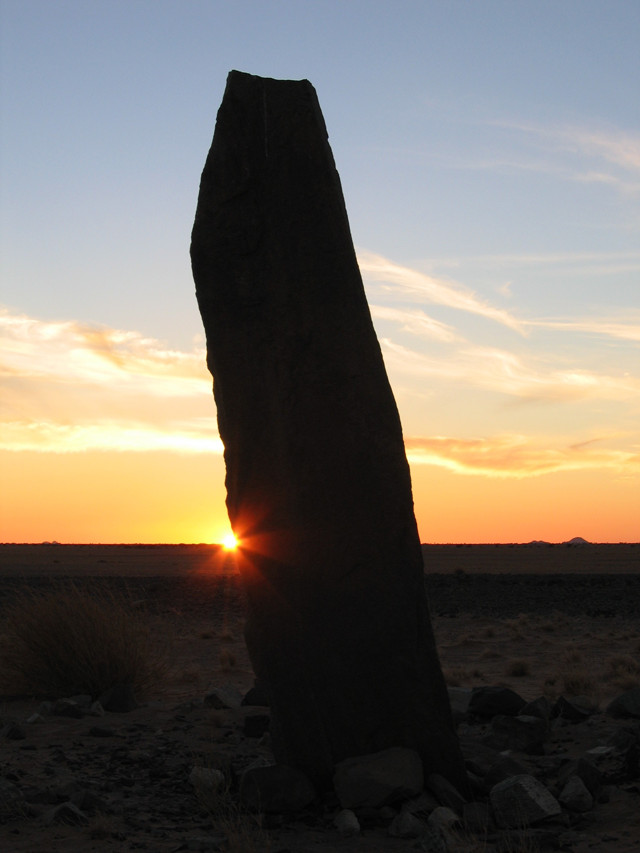Down to Earth With: Nick Brooks
by Erin Wayman
Tuesday, May 22, 2018

Nick Brooks surveys the landscape at Rekeiz Lemgassem, Western Sahara. Credit: Nick Brooks
More than 6,000 years ago, the world’s most famous desert was no desert at all. A wet, grassy landscape, the Sahara supported populations of hunter-gatherers. But between 5,000 and 6,000 years ago, the Sahara started to dry out. The rapid climate change forced the Sahara’s human inhabitants to adapt — some people became more sedentary and settled near oases while others took up cattle herding and traveled between the desert’s dwindling resources. Once the desert became too inhospitable to support even a pastoralist’s lifestyle, people migrated southward.
Climate scientist Nick Brooks, a visiting research fellow at the Tyndall Centre for Climate Change Research at the University of East Anglia in Norwich, England, studies this period of abrupt climate change and its impacts on the Saharan people. To this end, Brooks relies on the tools of both earth science and archaeology. He is also the director of the Western Sahara Project, a geoarchaeological expedition that seeks to better understand past environmental and social change in this little-studied part of North Africa.
To “earn a living,” as he puts it, Brooks also consults for institutions like the World Bank and the United Nations Development Programme, helping his clients understand how climate change will affect international development.
Brooks recently spoke with EARTH’s Erin Wayman about how climatic changes affect human societies — and what the past can tell us about our likely response to future climate change.
EW: How did you get interested in how humans adapt to climate change?
NB: That’s something that came out of archaeology and my love of working in deserts. My first post-doctoral job was working on an archaeological project in southern Libya. My role was to use remote sensing and ground penetrating radar to detect buried archaeological sites and sites that might yield information on past environments, like paleolakes and channels.
The key point for me was finding environmental evidence that the area had become hyperarid — all the surface water disappeared — by about 3,000 years ago, and the archaeological information was telling us that this was precisely when the Garamantian civilization [a civilization that thrived from about 3,000 to 1,500 years ago and relied on irrigated agriculture] started to develop. So you have this weird sort of coincidence that a region becomes hyperarid, becomes much less inhabitable … and at the same time, you get the beginnings of what became a very successful civilization, which seemed to go against all of the orthodoxy, in terms of the earliest civilizations being products of abundance and progress. I thought, “Oh, there’s something really interesting and sort of contrary going on here.” After that, I was hooked.

A pillar of lake sediments in southern Libya that dates back to the last time the Sahara Desert was wet. Credit: Nick Brooks
EW: When studying how people adapted to past climate change, what do you look for in the archaeological record?
NB: The key things that we’re looking for — and they’re often quite elusive [laughs] — are things like migration and evidence of changes in the way people produce their food and livelihood. Another thing that keeps cropping up in the archaeological record, coincident in space and time with rapid climatic change, is evidence of increases in inequality. These are usually expressed in the funerary records. In the Sahara, the evidence overwhelmingly indicates that the Sahara Megalithic [prehistoric megalithic monuments that are found across the Sahara Desert] is associated with the spread of cattle herding. There’s a pattern of the spread of monuments with the spread of cattle herders, and cattle herders also seem to move throughout the Sahara in response to increasing aridity in the middle Holocene.
EW: What do you mean by “an increase in inequality”?
NB: Basically, what we’re talking about is a reduction in the resource base, so key resources like water and pasture become scarce. As a result, you get more competition. Certain people, certain groups are going to be in more or less privileged positions in terms of access to those resources. The people with the most control over those resources will become powerful, and depending on the context, quite wealthy. You can see them as emerging elites. If you look at the Nile Valley and other parts of the world, it certainly looks like this was going on.
EW: Are there examples of other places where you see this?
NB: What we were seeing [in the Sahara] was the ultimate expression of a process of severe climatic and environmental change that really started about 6,000 years ago. The period between 5,000 and 6,000 years ago was the last time the global climate really reorganized itself. In that period, you have the establishment of the regular El Niño after a long period of quiescence. It’s also during this time that you get severe and profound desertification across the whole Northern Hemisphere’s subtropics, from West Africa to North-Central China and southern North America.
It is also during this period that the first large, urban civilizations emerge. If you look at the Nile Valley, Mesopotamia, South Asia, North-Central China and the northern coast of Peru — the five great cradles of civilization — you see evidence that complex social organizations, hierarchies and political institutions all emerge at a time of profound climatic change and in areas that were facing increasing resource scarcity. This period is really interesting to look at if you want to look at the effects of severe climate change on human societies.

A prehistoric crescent-shaped burial monument at Lajuad, Western Sahara. Credit: Nick Brooks
EW: How does studying past cultures help tell us what will happen in the future?
NB: Not everybody agrees with me. There are some very general lessons, not necessarily prescriptive things about precisely what we need to do. There’s a lot of activity at the moment trying to distribute funding to developing countries to adapt to climate change. What appears to be the main motivation is … “climate-proofing” — identifying interventions to make sure current development and planned development are not undermined by climate change. It’s about protecting the status quo.
If we look back at past episodes of severe and abrupt climate change, the last thing we see is stability. What you see are societies completely reorganizing themselves. The process of adaptation itself results in profound social change. Environmental change and adaptation is a disruptive process. You’re not going to maintain the status quo.
The other thing it tells us is that there are costs associated with adapting. This is something that really isn’t addressed today. It’s generally assumed that if we have enough funding and put it in the right place, then everything will be fine. But there are still going to be issues that we’re going to need to address.
The broad thing to say about looking at the past is it helps you to think through some of the possibilities. I think right now we’re seeing a lack of imagination because people don’t have that deep perspective.

Brooks (second from left) plans a route with Sahrawi colleagues in Western Sahara. Credit: Nick Brooks
EW: If you’re working for a group that is interested in “climate-proofing” and you say climate change brings societal upheavals, is there a conflict?
NB: A lot of the people in the organizations I’ve worked with are quite receptive to ideas that we need to rethink what we’re doing. … A lot of what happens with modern development is that traditional coping mechanisms are swept aside in the name of modernity and progress. And it has in some places, like the African Sahel, led to catastrophic failure and hundreds of thousands, probably millions of deaths because the developmental models that are being imposed can’t cope with the extreme environmental variability. There are ways of addressing uncertainty in what the climate is going to do, and a lot of these ways are already being practiced. So what we should be doing is giving more support to people who are practicing traditional livelihoods that help people cope with uncertainty, marginality and variability.
That doesn’t mean you have to freeze everything in the past. You can help pastoralists with technology, for example. You can use longer-term weather forecasting or satellite detection of rainfall to know where the good pasture is. There are lots of ways you can meld traditional knowledge with modern scientific methods. … Half the battle is getting people to think of the environment as something that’s dynamic; it’s trying to change people’s thinking to realize that human societies are embedded within a dynamic and variable environment.

Prehistoric megalithic monuments can be found all across the Sahara today. Credit: Nick Brooks
EW: How do the changes we’re facing compare to the changes the Sahara witnessed 5,000 years ago?
NB: It’s quite likely that in some parts of the world we’ll see change over the 21st century that’s broadly comparable to what happened in the Sahara 5,000 or 6,000 years ago. It’s likely that we’ll see similar responses. I read some years ago that because of drought in Kenya, a lot of [cattle] herders were settling permanently around Lake Turkana. There, people are migrating to an environmental refuge and adopting a sedentary lifestyle — that’s precisely what people did in the Sahara thousands of years ago as it was beginning to dry up. So today we do see very similar responses, identical responses in some instances, to those that happened millennia ago.





